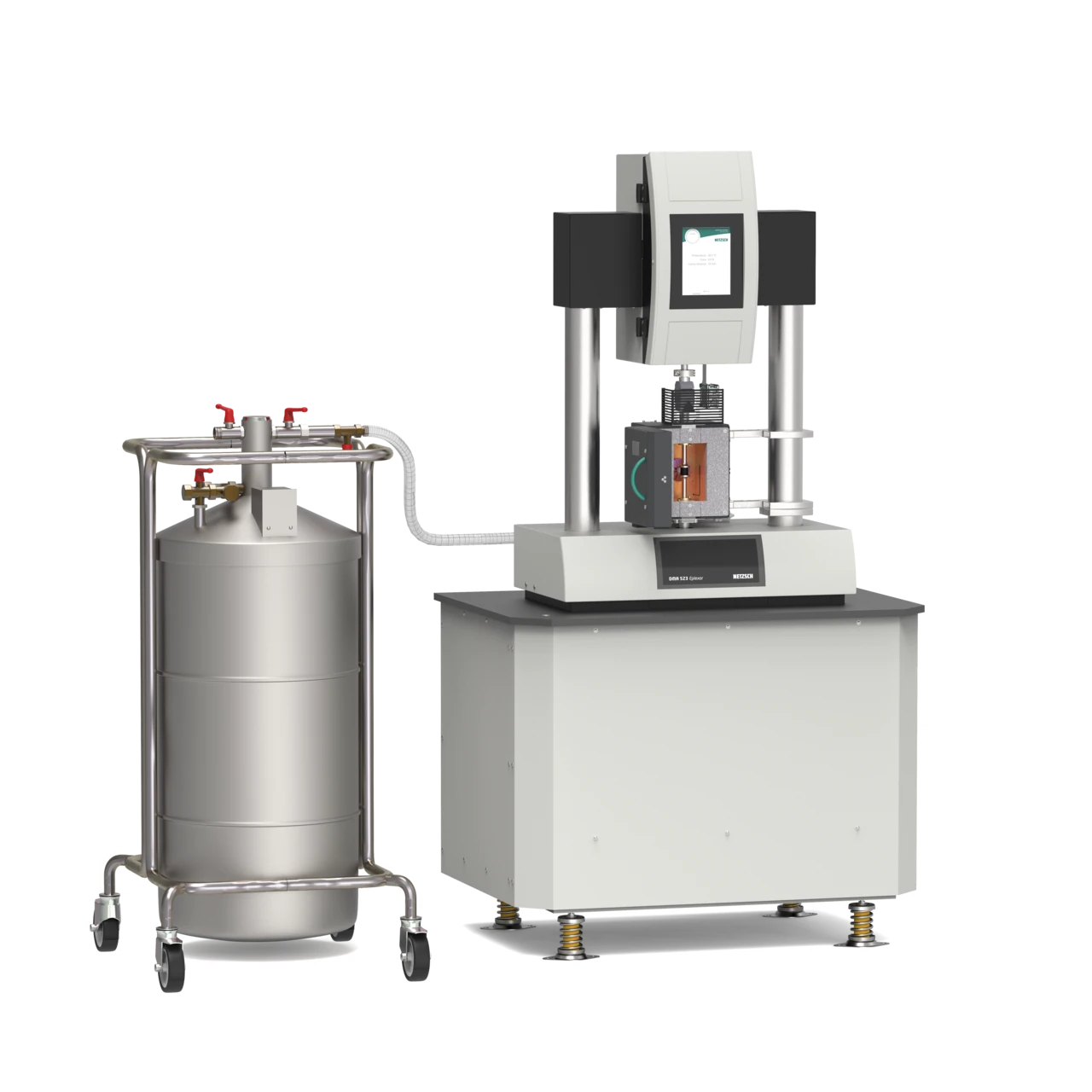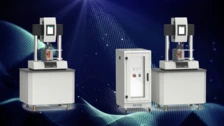Highlights
Static and additional dynamic force levels up to max. ± 4000 N
The NETZSCH DMA 523 Eplexor® is thus the perfect choice for investigating the dynamic-mechanical (or only static) properties of rigid samples as well as of specimens with larger dimensions – even component parts.
The following high-force DMA instruments are available:
| Instrument Type | Max. Static Force | Max. Dynamic Force |
|---|---|---|
| DMA 523 Eplexor® (2000 N) | 6000 N | ± 2000 N |
| DMA 523 Eplexor® (4000 N) | 6000 N | ± 4000 N |
Modular design to meet future needs
Thanks to their modular design, high-force DMA instruments can accommodate add-ons to additionally carry out tests on such properties as fatigue, heat build-up, blow-out and Rolling ResistanceThe rolling resistance is a force resisting the motion when a body is rolling across a surface. This determines the slip resistance of, e.g., car or truck tires.rolling resistance.
All testing machines in this series are based on standards such as DIN 53513, DIN 53533, ISO 6721/1, ISO 6721/4, ISO 6721/5, ISO 6721/6, ISO 4664, ISO 4666/3, ISO 4666/4, ASTM D623, ASTM D4065, and ASTM D4473.
Non-Stop Operation with the Second-to-None NETZSCH Autosampling Systems
By adding one of the two available autosampling systems (ASC – automatic sample changer or MPAS – multi-purpose automatic sample changer), any DMA Eplexor® can be converted to a fully-automatic testing system for up to 160 samples, supporting bending, tension, shear and compression modes. The unrivaled MPAS even facilitates the insertion of sample holders in arbitrary order.
Highly Economic LN2 Cooling
Optimized cooling control allows for low liquid nitrogen consumption while working at sub-ambient temperatures.
Sample Holders for a Variety of Applications
Samples of varied geometries and properties require adapted sample holders. To this end, NETZSCH offers a great selection of sample holders and measurement modes including specialties such as a holder for tire cord testing or for Curing (Crosslinking Reactions)Literally translated, the term “crosslinking“ means “cross networking”. In the chemical context, it is used for reactions in which molecules are linked together by introducing covalent bonds and forming three-dimensional networks.curing resins and liquids, respectively.
Method
Dynamic Mechanical Analysis (DMA) provides valuable insights into various aspects of material behavior. It offers information on viscoelastic properties such as storage and Viscous modulusThe complex modulus (viscous component), loss modulus, or G’’, is the “imaginary” part of the samples the overall complex modulus. This viscous component indicates the liquid like, or out of phase, response of the sample being measurement. loss modulus, loss factor, and tan δ.
Additionally, DMA allows the examination of stiffness and damping properties under diverse conditions, including temperature, frequency, StressStress is defined as a level of force applied on a sample with a well-defined cross section. (Stress = force/area). Samples having a circular or rectangular cross section can be compressed or stretched. Elastic materials like rubber can be stretched up to 5 to 10 times their original length.stress, StrainStrain describes a deformation of a material, which is loaded mechanically by an external force or stress. Rubber compounds show creep properties, if a static load is applied.strain, gas atmosphere, and liquid environments. It facilitates the identification of material reactions, Phase TransitionsThe term phase transition (or phase change) is most commonly used to describe transitions between the solid, liquid and gaseous states.phase transitions, and the Glass Transition TemperatureThe glass transition is one of the most important properties of amorphous and semi-crystalline materials, e.g., inorganic glasses, amorphous metals, polymers, pharmaceuticals and food ingredients, etc., and describes the temperature region where the mechanical properties of the materials change from hard and brittle to more soft, deformable or rubbery.glass transition temperature of highly cross-linked polymers and composites.
Moreover, DMA aids in assessing the compatibility of polymer blends based on composition and structure, as well as the impact of filler and additive contents. It also helps in understanding Curing (Crosslinking Reactions)Literally translated, the term “crosslinking“ means “cross networking”. In the chemical context, it is used for reactions in which molecules are linked together by introducing covalent bonds and forming three-dimensional networks.curing and post-Curing (Crosslinking Reactions)Literally translated, the term “crosslinking“ means “cross networking”. In the chemical context, it is used for reactions in which molecules are linked together by introducing covalent bonds and forming three-dimensional networks.curing processes of resins, analyzing aging influences, and predicting material behavior through Time-Temperature-Superposition (TTS).
Furthermore, DMA enables the study of CreepCreep describes a time and temperature dependent plastic deformation under a constant force. When a constant force is applied to a rubber compound, the initial deformation obtained due to the application of the force is not fixed. The deformation will increase with time.creep and RelaxationWhen a constant strain is applied to a rubber compound, the force necessary to maintain that strain is not constant but decreases with time; this behavior is known as stress relaxation. The process responsible for stress relaxation can be physical or chemical, and under normal conditions, both will occur at the same time. relaxation processes, contributing to a comprehensive understanding of material performance.
Specifications
Technical Data
- Temperature range: -160°C to 500°C
- Static force: 6000 N
- Dynamic force range: ± 2000 N, ± 4000 N (depending on instrument type; see table)
- Frequency range:0.0001 Hz to 100 Hz
- Static displacement: max. 70 mm
- Dynamic displacement: up to ± 15 mm (DMA 523 Eplexor® 2000N / 4000N); each instrument can be equipped with two StrainStrain describes a deformation of a material, which is loaded mechanically by an external force or stress. Rubber compounds show creep properties, if a static load is applied.strain transducers
- Automatic sample changer: max. 160 samples of the same geometry (ASC), also for differing sample holder geometries (MPAS)
Software
Speeding up Workflows
The technologically sophisticated DMA GABO Eplexor® 8 software is a perfect match for the DMA instrument. The software is based on the Windows™ operating system and offers comprehensive possibilities for data and curve analyses.
Predefined software packages are available in accordance with the selected clamping devices such as tension, compression or bending.
The software features are:
- Frequency sweep (0.01 - 100 Hz; optional 200 Hz; optional 0.0001 Hz; also optional: multi-frequency sweep)
- Time sweep
- Temperature sweep
- Static and dynamic StressStress is defined as a level of force applied on a sample with a well-defined cross section. (Stress = force/area). Samples having a circular or rectangular cross section can be compressed or stretched. Elastic materials like rubber can be stretched up to 5 to 10 times their original length.stress or StrainStrain describes a deformation of a material, which is loaded mechanically by an external force or stress. Rubber compounds show creep properties, if a static load is applied.strain sweep
- Temperature and frequency sweep – IsothermalTests at controlled and constant temperature are called isothermal.Isothermal frequency changes (temperature steps)
- Constant StressStress is defined as a level of force applied on a sample with a well-defined cross section. (Stress = force/area). Samples having a circular or rectangular cross section can be compressed or stretched. Elastic materials like rubber can be stretched up to 5 to 10 times their original length.stress amplitude mode per ASTM D623 (heat build-up test with static load and dynamic deformation – optional)
- Universal test driven by the servo motor (optional) or by the shaker (optional) -
- Time-temperature superposition – TTS (WLF, Arrhenius, numeric – optional)
- Evaluation of Complex ModulusThe complex modulus consists of two components, the storage and the loss moduli. The storage modulus (or Young’s modulus) describes the stiffness and the loss modulus describes the damping (or viscoelastic) behavior of the corresponding sample using the method of Dynamic Mechanical Analysis (DMA). complex modulus (E*, G*), storage modulus (E’, G’), Viscous modulusThe complex modulus (viscous component), loss modulus, or G’’, is the “imaginary” part of the samples the overall complex modulus. This viscous component indicates the liquid like, or out of phase, response of the sample being measurement. loss modulus (E´´, G´´), damping factor (tand), Glass Transition TemperatureThe glass transition is one of the most important properties of amorphous and semi-crystalline materials, e.g., inorganic glasses, amorphous metals, polymers, pharmaceuticals and food ingredients, etc., and describes the temperature region where the mechanical properties of the materials change from hard and brittle to more soft, deformable or rubbery.glass transition temperature, and optional CreepCreep describes a time and temperature dependent plastic deformation under a constant force. When a constant force is applied to a rubber compound, the initial deformation obtained due to the application of the force is not fixed. The deformation will increase with time.creep, RelaxationWhen a constant strain is applied to a rubber compound, the force necessary to maintain that strain is not constant but decreases with time; this behavior is known as stress relaxation. The process responsible for stress relaxation can be physical or chemical, and under normal conditions, both will occur at the same time. relaxation and retardation, fatigue, energy loss, Payne/Mullins effect analysis and crack growth testing -
- Hysteresis presentation of results (optional)
- Determination of thermal expansion (for tension mode – optional)
- Prediction of the Rolling ResistanceThe rolling resistance is a force resisting the motion when a body is rolling across a surface. This determines the slip resistance of, e.g., car or truck tires.rolling resistance of tires (optional)

Consultancy & Sales
Do you have further questions about the device, the method and would you like to speak to a sales representative?
Service & Support
Do you already have an device and need technical support or spare parts?
Related Devices
- DMA 303 Eplexor®
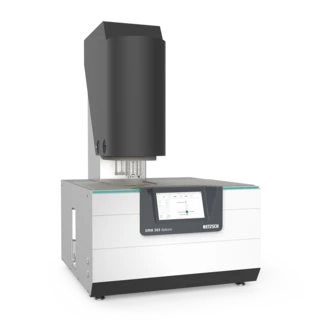
- Wide Temperature Range from -170°C to 800°C
- Precise Forces up to 50 N Dynamic and Static
- Accessories for Multiple Measuring Modes and a Variety of Sample Holders
- HBU 523 Gabometer
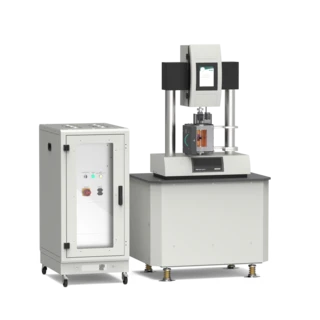
- Temperature Range up to 300°C
- Static force up to 6000N
- Static deformation up to 70 mm
- DMA Eplexor® HT Series up to 500 N
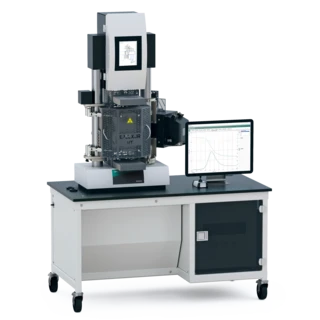
- Temperature Range up to 1500°C
- Static Force Range up to 1500 N
- Dynamic Force Range up to ± 500 N (1000 N) (depending on instrument version)
- DMA Eplexor® up to 500 N

- Two Independent Drives for Static and Dynamic Force
- Variety of Sample Holders for Handling the Tasks of Today and Tomorrow
